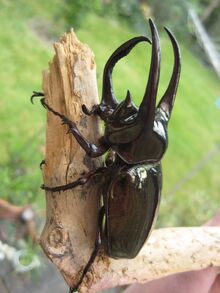| ⬅ #62 horned dynastid | #63 horned atlas |
#64 horned elephant ➡ |
| Horned atlas • | Gallery |
- "I caught a horned atlas! It's like a weight has been lifted!" —New Leaf
The horned atlas (コーカサスオオカブト, Kōkasasu-ōkabuto for the caucasus beetle?)
アトラスおカブトムシ atorasuokabutomushi for the atlas beetle ) is a bug found in Wild World, City Folk, New Leaf and New Horizons. It sells for 8,000 bells. Before New Leaf, it was known as the atlas beetle. It appears during summer evenings, between the months of July and August, roughly between the times 5pm and 8am. It is rumored that this bug appears more frequently when it's raining.
Donation to the museum[]
As with all bugs in the Animal Crossing series, the atlas beetle can be donated to the Museum by talking to Blathers, who will provide some information about it.
In Wild World[]
When donated to the museum, Blathers will say:
"I find most things about beetles like this repellant, but the MOST repellant are the thin wings that they keep hidden inside. You know of what I speak? After landing, seeing that little piece of wing sticking out of their backs! Blech! Just another example of how insects scoff at proper manners and tidiness!"
Once donated, the atlas beetle can be found on the bottom of the right palm tree in the first room of the bug exhibit.
In City Folk[]
When donated to the museum, Blathers will say:
"Crowned with three horns, the atlas beetle is known as the strongest of the dynastid beetles. Blech, I wonder if it had three horns when it was in its larval form... I simply loathe larvae. All squishy and squirmy... Nightmarish, really."
In New Leaf[]
In New Leaf an information board in the bug exhibit will list information about this bug.
"Horned atlases, though perhaps not the largest, are still known as the strongest of dynastid beetles. Their 3 horns make them look like a mash-up of a dynastid beetle and a stag beetle! In the pupal stage, they already have 3 horns and tend to be pretty strong."
After donation, the atlas beetle can be found on the middle terrace, on the first palm tree overlooking the scorpion, tarantula, and rafflesia flower.
In New Horizons[]
When either donating to the museum or selecting "Tell me more about this!", Blathers the curator will say (with abhorrence):
"Beware the horned atlas! I tell you, this rhinoceros beetle is known for its violent temperament! The males use the three large horns on their heads to fight amongst each other for dominance. But it is their young that truly give me the cold sweats. You see, their larvae grow quite large and, worst of all...they bite! It is the stuff of nightmares, I say."
Capture quotes[]
| Japanese Quotes |
|---|
|
「コーカサスオオカブトを つかまえた! 黒光りして 強そ~っ!」 —New Leaf
|
- "I caught an atlas beetle! It's black and looks tough! It's the strongest beetle!" —Wild World
- "I caught an atlas beetle! At last, beetle!" —City Folk
- "I caught an atlas beetle! I didn't even need a map!" —New Horizons
Encyclopedia Information[]
Wild World[]
Bug
|
Encyclopedia Information
| |

|
"These beetles are the strongest in the world." | |
| Size | 120 mm | |
| Time | Night | |
| Season | Summer | |
| Icon | ||
City Folk[]
Bug
|
Encyclopedia Information
| ||||||||

|
| ||||||||
New Leaf[]
Bug
|
Encyclopedia Information
| ||||||||

|
| ||||||||
Further Information[]

The atlas beetle is found in southern Asia, specifically Malaysia. It is mostly distinguished by its large horns, which make up males can reach 110 mm , while females reach 45-70mm
It uses its horns to fight other male atlas beetles for a mate - the female atlas beetle is smaller and lacks horns.
The larva is pale yellow with black markings and a pale blue underbelly in appearance, and is known to bite when touched, and is also known to fight to the death with other atlas beetle larvae, the larva spend 1-2 years tunneling in rotten wood . It can carry 4 kilograms, which is the equivalent of a human being carrying two elephants - this gives it the reputation of being one of the strongest animals on earth for its size.
In the Japanese version the horned atlas is referred as the caucasus beetle, Chalcosoma caucasus, it is another larger type of Chalcosoma beetle; it is known for it's large size making it the largest of all Chalcosoma beetles.
In other languages[]
Trivia[]
- It is most likely a caucasus beetle due to it's horn shape.
| Bugs | |||||||||
|---|---|---|---|---|---|---|---|---|---|
|
| |||||||||
| |||||||||
